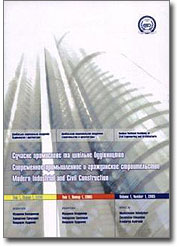Numerical Tests of Concrete Samples
Abstract: The results of numerical testing of concrete prisms and cubes by limit loads are presented. Strategy of testing is based on new calculation models of concrete as anisotropic material that have different strength under press and tension. The equations of the plastic state based on the hypotheses of the Flow Theory of Plasticity, unified for different materials, such as soil ground, concrete, metal, etc. are used. For all materials, the strength theory of Mises-Schleicher-Botkin is used. The strength characteristics of materials, determined by standard methods, are redefined for octahedral sites, for which they are invariants. The problem is solved by the finite element method (FEM). The computational model of the FEM is represented by singular finite elements (tetrahedral, triangular plates, rods). This increases the accuracy of the description of loading paths in finite elements and ensures a unique correspondence of the state equations to elementary volumes of the construction. The use of singular finite elements is associated with a large amount of RAM for storing the stiffness matrix of the system, which significantly limits the range of practically solvable problems. To eliminate this contradiction, an iterative Newton – SUR method has been accepted for solving equilibrium equations in the design of finite element structures. An iterative algorithm was used, which does not require an assembly of the system stiffness matrix for its implementation. The volume of operational information is proportional to the number of finite elements in the system. With the traditional approach, which requires the assembly of the system’s stiffness matrix, the amount of operational information is proportional to the square of the degree of kinematic indeterminacy of the system. When using the iterative algorithm, the size of the stiffness matrix is reduced and the time of solving the problem is significantly reduced. The results of a nonlinear analysis of concrete structures are presented. It is shown that the work of concrete on the descending branch is a property of the design of the sample, and not a property of the material. The downward branch of the concrete work is a consequence of the destruction of the material due to volumetric stretching and can be obtained outside the framework of dilatancy models.
Keywords: anisotropic model of concrete, theory of plastic flow, descending branch of concrete work.
Pages: 41-50.
For citation:
For citation: Panasiuk, M. D.; Petrakov, A. A.; Petrakova, N. A. Numerical Tests of Concrete Samples. – Text : electronic. – In: <em>Modern Industrial and Civil Construction</em>. – 2021. – Vol. 17, N 1. – Р. 41-50. – URL: https://donnasa.ru/publish_house/journals/spgs/2021-1/04_panasyuk_petrakov_petrakova.pdf (date of access: 09.05.2025). – ISSN 1993-3495.

Vol. 17, N 1 (2021)
Journal: Modern Industrial and Civil Construction
Publish house: Donbas National Academy of Civil Engineering and Architecture
Journal: Modern Industrial and Civil Construction
Publish house: Donbas National Academy of Civil Engineering and Architecture
